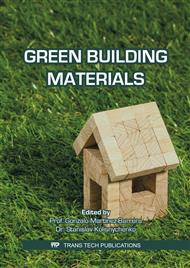[1]
A. S. Negi, M. Faizan, D. P. Siddharth R. Singh, Soil stabilization using lime, J. Innovative Research in Sci, Eng. and Tech. 2 (2013) 448-453.
Google Scholar
[2]
Rovaniemi, S. Timo, Road condition management of low traffic volume roads in the Northern Periphery, Roadex Sub Project A Phase I State of the Art Study Report, (2000).
Google Scholar
[3]
S.M. Lim, D.C. Wijeyesekera, A.J.M.S. Lim, I.B.H. Bakar, Critical review of innovative soil road stabilization techniques, Int. J. of Eng. and Advanced Tech. 3 (2014) 204-211.
Google Scholar
[4]
M. M. E. Zumrawi, Survey and evaluation of flexible pavement failures, Int. J. of Sci and Research, 4 (2015) 1602-1607.
Google Scholar
[5]
P. Kumar, A. Gupta, Cases studies of bituminous pavements, International Conference on Pavement Preservation. 5 (2010) 505-518.
Google Scholar
[6]
U. Athira, A.K Mithrathmajan, S. Rajkumar, V. Meril, M.B. Neenu, Efficacy og geosynthetics in subgrade stabilization – a comparative study in laterite soil, International J. of Innovative Research in Sci, Eng. and Tech., 6 (2017) 6709-6716.
Google Scholar
[7]
J.G. Zomberg, Advances in the use of geosynthetic in pavement design, J. of Geotechnical and Geoenvironemental Eng., 136 (2008) 276-277.
Google Scholar
[8]
A. Charles, Y. Nana, R. Opoku, Effect of geogrid reinforced subgrade on layer thickness design of low volume bituminous seales road pavements, International Refered J. of Eng. and Sci, 3 (2014) 62-66.
Google Scholar
[9]
A. S. Akolade, O. S. Olaniyan, Application of geogrids on the geotechnical properties of subgrade materials under soaked condition, International Institute for Sci. Tech. and Edu. 6 (2014) 12-19.
Google Scholar
[10]
European Parliament, EU road surface: economic and safety impact of the lack of regular road maintenance, Directorate General for Internal Policies, (2014) 30-31.
Google Scholar
[11]
P.T. Sherwood, M.D. Ryley, The use of stabilized pulverized fuel ash in road construction, Road Research Laboratory, RRL Report No 49 (1966).
Google Scholar
[12]
Masirin, Mohd Idrus Hj Mohd; Eda Edayu Binti Anuar; Adnan Zainorabidin and Ismail Hj Bakar; Analysis On The Long Term Effect Of Trial Test Road Constructed On Batu Pahat Soft Clay (BPSC) At RECESS UTHM; IOP Conference Series: Materials Science and Engineering, IOP Publishing Ltd, 136, 1, IOP Publishing Ltd, 1-6, ISSN:17157899X (2017).
DOI: 10.1088/1757-899x/136/1/012025
Google Scholar
[13]
E.B. Pancar, M.V. Akpinar, Comparison of effects of using Geosynthetics and lime stabilization to increase bearing capacity of unpaved road subgrade, Advances in Materials Sci. and Eng. (2016) 1-8.
DOI: 10.1155/2016/7129356
Google Scholar
[14]
F. Leiva-Villacorta, A. Vargas-Nordcbeck, J.P. Aguiar-Moya, Permanent deformation and deflection relationship from pavement condition assessment, International J. of Pavement Research and Technology, 10 (2017), 352-359.
DOI: 10.1016/j.ijprt.2017.03.005
Google Scholar
[15]
D.C Onuoha, S.U Onwuka, E.A. Obienusi, Evaluating the causes of the road failure of Onitsha_enugu Expressway, Southeastern Nigeria, Civil and Eng. Research, 6 (2014), 118-125.
Google Scholar
[16]
M. A. Kestler, Stabilization selection guide for aggregate and native surfaced low volume roads, US Department of Agriculture (2009).
Google Scholar
[17]
Nordin, N.H., Mohd Masirin, M.I., Ghazali, M.I., Azis, M.I., Passenger rail service comfortability in Kuala Lumpur urban transit system, MATEC Web of Conferences (2016), 47, 03011.
DOI: 10.1051/matecconf/20164703011
Google Scholar
[18]
Usman, N., Masirin, M.I.B.M., Ahmad, K.A., Wurochekke, A.A., Reinforcement of asphalt concrete mixture using recycle polyethylene terephthalate fibre, Indian Journal of Science and Technology (2016), 9(46), 107143.
DOI: 10.17485/ijst/2016/v9i46/107143
Google Scholar
[19]
Masirin, M.I.M., Al Allam, A.M., Ali, A.S.B., Effect of Batu Pahat Soft Clay (BPSC) concentrations on the physical and rheological properties of asphalt binder, Pertanika Journal of Science and Technology, 25(5), pp.101-108, (2017).
Google Scholar
[20]
AL Allam, A.M., Mohd Masirin, H.M.I.B.H., Abdullah, M.E., Kamarudin, N.H.M: Influence of using Batu Pahat Soft Clay on the mechanical properties of hot mix asphalt mixture: ARPN Journal of Engineering and Applied Sciences: (2016).
Google Scholar
[22]
Usman, N., Masirin, M.I.M., Ahmad, K.A., Ali, A.s.B.: Application of Recycled polyethylene terephthalate fiber in Asphaltic mix for fatigue life improvement: Lecture Notes in Civil Engineering: (2019).
DOI: 10.1007/978-981-10-8016-6_101
Google Scholar



